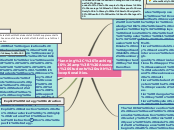Planning, Teaching & Assessing Students with Exceptionalities.
Before: States purpose, introduces new vocabulary, clarifies concepts from the prior knowledge in a visual organizer. During: Displays directions in a chart, poster or list. After: Facilitates a discussion to highlight or make more explicit the significant concepts or skills and then presents summary and list of important concepts as they relate to one another.
The gigted students should be introduced to the "joys & frustrations pf thinking deeply about a wide range of original, open-ended, or complex problems that encorage them to respond creatively in way that are original, fluent, flexible and elegant".
Acceleration, Enrichment, Sophistication,Novelty, Strategies to avoid.
Planning for students who are Mathematically Gifted
Multi-tiered models are basically centered on three interwoven elements: high-quality curriculum, instructional support, formative assessment that capture students' strengths and weaknesses. RtI is a multi-tiered students support system that is frequently represented in a three-tier triangular format. A key to the multi-tiered system of support is the monitoring of students' progress. Combining instruction with short daily assessment to monitor students; knowledge of number combinations that were already taught proved that the students were not only better at remembering but also better at generalizing to the other facts.
Multi-tiered System of Support
Response to intervention
The CSA intervention has been used in mathematics education in a variety of forms for years. This model reflects a sequence that begins with an instructional focus on concrete representations & tools, then moves to semi-concrete representations & abstractions over time.
Concrete, Semi-Concrete, Abstract (CSA)
Think-Aloud You demonstrate the steps to accomplish a task while verbalizing the thinking processes and reasoning that accompany the steps.
Adapting for Students with moderate or severe disabilities.
Peer-Assisted Learning
Students with special needs also benefit from other students' modeling and support. The students can be paired with older students or peers who have more sophisticated understanding of a concept.
1. What organizational, behavioral, and cognitive skills are necessary for students with disabilities to derive meaning? 2. Which students have known weaknesses in any of these skills or concepts? 3. How can I provide additional support in these areas of weakness so that students with learning disabilities can focus on the conceptual task in the activity?
Tiers 1, 2 & 3
Incorporates high-quality rigorous curriculum and has expectations for all students to be challenged.
Works with students in supplemental sessions outside of the core instruction
Works one-on-one students
Implementing Interventions
Addressing the needs of all students means providing access and opportunity for: Students who are identified as struggling or having a disability. Students who are mathematically gifted. Students who are unmotivated or need to build resilience.
Instructional Principal for Diverse Learners
